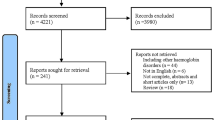Abstract
Objective: For adolescent thalassaemic patients, parenteral iron-chelation therapy is still a burden and a major reason for unsatisfactory compliance. The introduction of a new pharmaceutical preparation of deferoxamine (Desferal) claimed to be better tolerated was accompanied by an epidemiological study on the quality of care and life of the Italian thalassaemic population and on the acceptability and safety profile of the new preparation compared with the old one. Methods: This was a two-period prospective survey of 867 patients (12% of the registered thalassaemic patient population) in a sample of centres representative of the different contexts of care. Results: The majority of patients (81%) reported an overall positive opinion about the quality of care (median satisfaction score 7.4). Judgement was more critical among patients over 15 years, unemployed, less compliant with chelation treatment and with higher mean serum ferritin levels. The co-morbidity profile did not appear to influence patients' satisfaction scores, but 21% of respondents associated great discomfort with the use of Desferal, which appeared in a multivariate analysis to be a strong predictor [odds ratio (OR) 2.15, 95% confidence interval (CI) 1.20–3.83] of negative perception. Quality of life was reported as fair or poor (score below 6) by 21% of patients. Over a total of 29,066 infusions included in the comparison of the safety of the new versus the old preparation, the reported incidences of any adverse event (AE) were 51% versus 57%, respectively, and 8.2% versus 9.3% for severe AEs. Comparing the new with the old preparation, the adjusted relative risk of severe AEs was 0.79 (95% CI 0.65–0.96). Conclusion: While oral chelation therapies are still under evaluation, the overall quality of care and perceived quality of life of a representative sample of the Italian population of thalassaemic patients show that room for improvement depends more on the contexts of life and care than on strictly medical conditions. Comprehensive epidemiological surveillance is needed as a routine component of the care of this highly morbidity-burdened population to ensure timely appreciation of unmet needs and to assess the yield of innovative treatment schedules.
Similar content being viewed by others
Author information
Authors and Affiliations
Additional information
Accepted in revised form: 17 November 2000
Electronic Publication
Rights and permissions
About this article
Cite this article
Arboretti, R., Tognoni, G. & Alberti, D. Pharmacosurveillance and quality of care of thalassaemic patients. Eur J Clin Pharmacol 56, 915–922 (2001). https://doi.org/10.1007/s002280000251
Received:
Published:
Issue Date:
DOI: https://doi.org/10.1007/s002280000251




